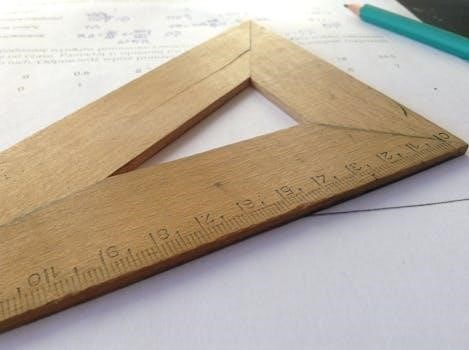AP Precalculus⁚ A Comprehensive Study Guide Overview
This AP Precalculus study guide provides students with resources and
strategies for exam success. It covers course content, exam format, and
effective study techniques, to assist in achieving a high score on the
AP Precalculus exam.

Course Content and Structure
The AP Precalculus course is designed to prepare students for college-level
mathematics. The course framework is organized into four units, focusing on
functions, rates of change, and essential precalculus concepts. It builds
upon algebra and trigonometry.
Key Topics Covered in AP Precalculus
AP Precalculus covers a range of essential topics to prepare students for
college-level math. Key areas include functions, exploring polynomial,
rational, exponential, logarithmic, and trigonometric functions. Students
will delve into rates of change, concavity, and end behavior. The course
also emphasizes algebraic expressions, real numbers, and fundamental
concepts. Furthermore, it focuses on mastering concepts from algebra and
trigonometry, ensuring a strong foundation. This includes the use of limit
notation and understanding functions’ behavior. Ultimately, the curriculum
aims to equip students with skills for success in calculus.
The Four Units of Study
The AP Precalculus course is structured into four main units, providing a
logical sequence for learning. These units are designed to cover all
essential knowledge and skills required for college credit. Units 1, 2, and
3 are specifically assessed on the end-of-course AP Exam. The curriculum
covers functions, rates of change, and algebraic concepts. Each unit builds
upon the previous one, ensuring a comprehensive understanding. The
framework emphasizes what students should know and be able to do. College
faculty and high school teachers guide the development of these units. These
units offer one possible sequence for the course.

Exam Preparation Strategies
To ace the AP Precalculus exam, focus on understanding the exam format,
utilizing AP Classroom resources, and practicing with past papers;
Effective study habits and review videos are also helpful for success.
Utilizing AP Classroom Resources
AP Classroom offers a wealth of resources to prepare for the
AP Precalculus exam. Students can access practice questions, unit
assessments, and personalized feedback to identify areas for improvement.
The platform also includes video explanations, strategy guides, and guided
notes to enhance understanding of key concepts. Teachers can use
AP Classroom to track student progress and tailor instruction to meet
individual needs. By actively engaging with these resources, students can
build confidence and improve their performance on the AP Precalculus
exam. These tools are designed to support a comprehensive review of the
course material.
Practice Tests and Scoring Guidelines
Engaging with practice tests is crucial for AP Precalculus exam
preparation. These tests simulate the actual exam environment, helping
students become familiar with the question types and time constraints.
Each practice test should be followed by a thorough review using the
official scoring guidelines. Understanding how points are awarded
allows students to identify areas where they can improve their problem-solving
strategies. The scoring guidelines provide detailed explanations of
the criteria used to evaluate responses, enabling students to learn from their
mistakes and refine their approach; Regular use of practice tests and
scoring guidelines enhances exam readiness and boosts confidence.

Calculator Usage
Effective calculator usage is vital for the AP Precalculus exam.
Understanding the approved models and their functionalities can significantly
enhance problem-solving speed and accuracy. Familiarize yourself with your
calculator!
Graphing Calculator Requirements
The AP Precalculus exam requires a graphing calculator for specific
sections, making its proper usage essential. Part B of Section I (Multiple
Choice) and Part A of Section II (Free Response) both permit and expect
graphing calculator utilization. Students should familiarize themselves with
approved models, ensuring they meet College Board’s requirements. Key
functionalities include graphing functions, solving equations, and performing
statistical analysis. Proficiency in these areas will significantly enhance
exam performance. Understanding how to efficiently use the calculator to
solve problems and interpret results is crucial. Prior practice with the
graphing calculator is highly recommended to avoid errors and maximize time
management during the exam.
Technology and Accessibility Considerations
Beyond graphing calculators, understanding broader technological tools and
accessibility options is crucial for the AP Precalculus exam. Students
should be aware of any available accommodations for disabilities, ensuring
they meet College Board’s guidelines. Familiarity with online resources, such
as AP Classroom, can enhance learning and exam preparation. Accessibility
features on graphing calculators, like screen readers or alternative input
methods, should be explored if needed. Schools and students must verify that
all technology adheres to the exam’s regulations to prevent any disruptions
during testing. Effective use of technology, combined with awareness of
accessibility options, promotes a fair and equitable testing environment for
all participants.
Free Response Question Strategies
Mastering free response questions (FRQs) is key to AP Precalculus exam
success. Strategies include understanding question types, utilizing proper
notation, showing all work, and effectively managing time to maximize points
earned.
Tackling Different FRQ Types
AP Precalculus free response questions (FRQs) assess various skills.
Some FRQs require algebraic manipulation, graphical analysis, or function
transformations. Others involve modeling real-world scenarios with functions
and interpreting results. Strategy videos can assist in understanding the
approach needed.
Carefully analyze each question to identify the core concepts being tested.
Practice with released questions and scoring guidelines to familiarize
yourself with the format and expectations. Pay attention to the wording of
the question to ensure you are addressing all requirements.
Develop problem-solving skills to approach different FRQ types.
Understanding the Grading Rubric
The AP Precalculus exam uses a specific grading rubric for evaluating
free response questions (FRQs). Each FRQ is scored based on a
detailed rubric that outlines the points awarded for different aspects of the
solution. Understanding the rubric is crucial for maximizing your score on
the exam.
The rubric typically assesses mathematical accuracy, clarity of explanation,
and appropriate use of notation. Points are often awarded for setting up the
problem correctly, showing intermediate steps, and arriving at the correct
answer. Clear explanations are key.
Familiarize yourself with the rubric by reviewing released FRQs and
their corresponding scoring guidelines.

Study Resources and Materials
To succeed in AP Precalculus, utilize diverse resources like study
guides, practice problems, and video explanations. These materials reinforce
concepts, improve problem-solving skills, and boost overall exam
preparedness.
Available Study Guides and Resources
A variety of study guides and resources are available to support your
AP Precalculus preparation. These include comprehensive guides that cover
all course topics, practice exams with rationales, and scoring guidelines.
Many resources are designed by experienced teachers and college faculty to
align with the AP course framework. Look for materials that offer clear
explanations, worked-out examples, and practice problems. Free online
resources and paid guides can be found to suit different learning styles
and budgets. Utilize these tools to reinforce your understanding and
improve your exam readiness. These resources will ensure a well rounded
knowledge of all essential topics.
Video Explanations and Practice Problems
Enhance your AP Precalculus preparation with video explanations and
practice problems. Many online resources offer video tutorials covering the
entire curriculum, providing easy-to-understand explanations and worked-out
examples. These videos often include strategies for tackling different types
of problems, including free-response questions. Practice problems are
essential for reinforcing your understanding and building problem-solving
skills. Look for resources that offer a variety of practice questions with
detailed solutions. Video explanations and practice problems can help you
visualize concepts and master the skills needed to succeed on the
AP Precalculus exam. Combining visual learning with practical application
will greatly improve your understanding and confidence.
